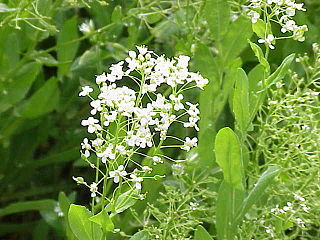Related Research Articles

Brassicaceae or Cruciferae is a medium-sized and economically important family of flowering plants commonly known as the mustards, the crucifers, or the cabbage family. Most are herbaceous plants, while some are shrubs. The leaves are simple, lack stipules, and appear alternately on stems or in rosettes. The inflorescences are terminal and lack bracts. The flowers have four free sepals, four free alternating petals, two shorter free stamens and four longer free stamens. The fruit has seeds in rows, divided by a thin wall.

Coriander is an annual herb in the family Apiaceae. It is also known as Chinese parsley, dhania, or cilantro. All parts of the plant are edible, but the fresh leaves and the dried seeds are the parts most traditionally used in cooking.

Cress, sometimes referred to as garden cress to distinguish it from similar plants also referred to as cress, is a rather fast-growing, edible herb.

Used in perfumery and aromatherapy, absolutes are similar to essential oils. They are concentrated, highly aromatic, oily mixtures extracted from plants. Whereas essential oils are produced by distillation, boiling or pressing, absolutes are produced through solvent extraction, or more traditionally, through enfleurage.

Pumpkin seed oil is a culinary oil, used especially in central Europe.

Leaf vegetables, also called leafy greens, salad greens, pot herbs, vegetable greens, or simply greens, are plant leaves eaten as a vegetable, sometimes accompanied by tender petioles and shoots. Although they come from a very wide variety of plants, most share a great deal with other leaf vegetables in nutrition and cooking methods.
Cress may refer to:

Lepidium is a genus of plants in the mustard/cabbage family, Brassicaceae. The genus is widely distributed in the Americas, Africa, Asia, Europe, and Australia. It includes familiar species such as garden cress, maca, and dittander. General common names include peppercress, peppergrass, pepperweed, and pepperwort. Some species form tumbleweeds. The genus name Lepidium is a Greek word meaning 'small scale', which is thought to be derived from a folk medicine usage of the plant to treat leprosy, which cause small scales on the skin. Another meaning is related to the small scale-like fruit.

Lepidium campestre, the field pepperwort or field pepperweed or field cress, is usually a biennial with some form of annual plant in the Brassicaceae or mustard family, native to Europe, but commonly found in North America as an invasive weed. The most notable characteristic of field pepperweed is the raceme of flowers which forks off of the stem. These racemes are made up of first small white flowers and later green, flat and oval seedpods each about 6 mm long and 4 mm wide. Each seedpod contains two brown, 2.5 mm long seeds.
Candlenut oil or kukui nut oil is extracted from the nut of Aleurites moluccanus, the candlenut or kuku'i.

Lepidium draba, the whitetop or hoary cress, or Thanet cress, is a rhizomatous perennial flowering plant in the family Brassicaceae. It is native to western Asia and southeastern Europe and widely introduced elsewhere.
Seed oils are vegetable oils obtained from the seed (endosperm) of some plants, rather than the fruit (pericarp). Most vegetable oils are seed oils. Examples are sunflower, corn, and sesame oils.

Myrosinase is a family of enzymes involved in plant defense against herbivores, specifically the mustard oil bomb. The three-dimensional structure has been elucidated and is available in the PDB.

Coronopus is a synonym for the accepted genus name Lepidium. It was applied to some species of flowering plants in the cabbage and mustard family Brassicaceae known commonly as swinecress or wartcress. These are generally low spreading annual herbaceous plants with many long stems, deeply lobed leaves and small white flowers. They have a strong scent, smelling like garden cress, Lepidium sativum, when crushed. Lepidium squamatus may be native to the Mediterranean but Lepidium didymum may be native to South America. Both species are widespread weedy introduced species in other areas.

Lepidium didymum, the lesser swine-cress, is a species of flowering plant in the family Brassicaceae.

Spices have been around in conjunction with human use for millennia, with many civilizations in antiquity that have used a variety of spices for their common qualities. The variety of spices were used for common purposes across the ancient world, and they were also used to create a variety of products designed to enhance or suppress certain sensations. Spices were also associated with certain rituals to perpetuate a superstition or fulfill a religious obligation, among other things.

Lepidium heterophyllum,, is a species of flowering plant in the mustard family which is native to parts of western Europe, growing in shingle banks, wasteland or cultivated fields.

Lepidium coronopus,, is a species of flowering plant in the mustard family which is native to parts of Africa, western Asia and Europe, growing in shingle banks, wasteland or cultivated fields.
References
- ↑ Diwakar, Bastihalli Tukaram; Dutta, Pinto Kumar; Lokesh, Belur Ramaswamy; Naidu, Kamatham Akhilender (2010). "Physicochemical Properties of Garden Cress (Lepidium sativum L.) Seed Oil". Journal of the American Oil Chemists' Society. 87 (5): 539. doi:10.1007/s11746-009-1523-z. S2CID 84640977.
- ↑ Umesha, S.S.; Naidu, K. Akhilender (2012). "Vegetable oil blends with α-linolenic acid rich Garden cress oil modulate lipid metabolism in experimental rats". Food Chemistry. 135 (4): 2845–2851. doi:10.1016/j.foodchem.2012.05.118. PMID 22980881.